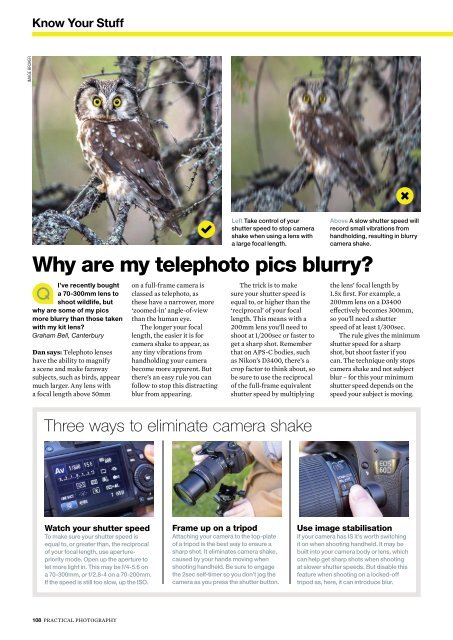Practical Photography
You also want an ePaper? Increase the reach of your titles
YUMPU automatically turns print PDFs into web optimized ePapers that Google loves.
Know Your Stuff<br />
IMAGE BROKER<br />
I’ve recently bought<br />
a 70-300mm lens to<br />
shoot wildlife, but<br />
why are some of my pics<br />
more blurry than those taken<br />
with my kit lens?<br />
Graham Bell, Canterbury<br />
Dan says: Telephoto lenses<br />
have the ability to magnify<br />
a scene and make faraway<br />
subjects, such as birds, appear<br />
much larger. Any lens with<br />
a focal length above 50mm<br />
on a full-frame camera is<br />
classed as telephoto, as<br />
these have a narrower, more<br />
‘zoomed-in’ angle-of-view<br />
than the human eye.<br />
The longer your focal<br />
length, the easier it is for<br />
camera shake to appear, as<br />
any tiny vibrations from<br />
handholding your camera<br />
become more apparent. But<br />
there’s an easy rule you can<br />
follow to stop this distracting<br />
blur from appearing.<br />
Left Take control of your<br />
shutter speed to stop camera<br />
shake when using a lens with<br />
a large focal length.<br />
Why are my telephoto pics blurry?<br />
The trick is to make<br />
sure your shutter speed is<br />
equal to, or higher than the<br />
‘reciprocal’ of your focal<br />
length. This means with a<br />
200mm lens you’ll need to<br />
shoot at 1/200sec or faster to<br />
get a sharp shot. Remember<br />
that on APS-C bodies, such<br />
as Nikon’s D3400, there’s a<br />
crop factor to think about, so<br />
be sure to use the reciprocal<br />
of the full-frame equivalent<br />
shutter speed by multiplying<br />
Above A slow shutter speed will<br />
record small vibrations from<br />
handholding, resulting in blurry<br />
camera shake.<br />
the lens’ focal length by<br />
1.5x first. For example, a<br />
200mm lens on a D3400<br />
effectively becomes 300mm,<br />
so you’ll need a shutter<br />
speed of at least 1/300sec.<br />
The rule gives the minimum<br />
shutter speed for a sharp<br />
shot, but shoot faster if you<br />
can. The technique only stops<br />
camera shake and not subject<br />
blur – for this your minimum<br />
shutter speed depends on the<br />
speed your subject is moving.<br />
Three ways to eliminate camera shake<br />
Watch your shutter speed<br />
To make sure your shutter speed is<br />
equal to, or greater than, the reciprocal<br />
of your focal length, use aperturepriority<br />
mode. Open up the aperture to<br />
let more light in. This may be f/4-5.6 on<br />
a 70-300mm, or f/2.8-4 on a 70-200mm.<br />
If the speed is still too slow, up the ISO.<br />
Frame up on a tripod<br />
Attaching your camera to the top-plate<br />
of a tripod is the best way to ensure a<br />
sharp shot. It eliminates camera shake,<br />
caused by your hands moving when<br />
shooting handheld. Be sure to engage<br />
the 2sec self-timer so you don’t jog the<br />
camera as you press the shutter button.<br />
Use image stabilisation<br />
If your camera has IS it’s worth switching<br />
it on when shooting handheld. It may be<br />
built into your camera body or lens, which<br />
can help get sharp shots when shooting<br />
at slower shutter speeds. But disable this<br />
feature when shooting on a locked-off<br />
tripod as, here, it can introduce blur.<br />
108 PRACTICAL PHOTOGRAPHY

















